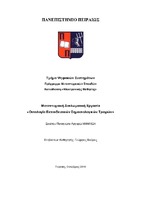| dc.contributor.advisor | Βούρος, Γεώργιος | |
| dc.contributor.author | Σακέτου, Παναγιώτα - Αργυρώ | |
| dc.date.accessioned | 2018-11-07T09:43:32Z | |
| dc.date.available | 2018-11-07T09:43:32Z | |
| dc.date.issued | 2018 | |
| dc.identifier.uri | https://dione.lib.unipi.gr/xmlui/handle/unipi/11523 | |
| dc.description.abstract | Στόχος της διπλωματικής αυτής είναι η ανάπτυξη οντολογίας καταγραφής σημασιολογικών μαθησιακών τροχιών των εκπαιδευομένων. Σκοπός της καταγραφής των μαθησιακών τροχιών είναι να παρέχει πληροφορίες που αφορούν τη πορεία των μαθητών κατά τη μαθησιακή διαδικασία ή την πορεία τους στη μάθηση στις διάφορες βαθμίδες της εκπαίδευσης. Άρα η οντολογία παρέχει πληροφορίες που μπορούν να χρησιμοποιηθούν για την αξιολόγηση προγραμμάτων σπουδών, για τη διαμόρφωση της αξιολόγησης των μαθητών, για τη δημιουργία αναφορών της πορείας των μαθητών σε μία μαθησιακή διαδικασία, για το σχεδιασμό εκπαιδευτικών πρακτικών και για την ομαλή ένταξη συγκεκριμένων ομάδων εκπαιδευομένων όπως οι πρόσφυγες. Έτσι μπορεί να αποτελέσει χρήσιμο εργαλείο για τους εκπαιδευτικούς, τους ερευνητές και τους ειδικούς στον εκπαιδευτικό σχεδιασμό.
Η οντολογία εκτός από την καταγραφή των μαθησιακών τροχιών μπορεί επίσης να αποτυπώσει και προσχεδιασμένη τροχιά του μαθητή όπως προτείνεται στην εκπαιδευτική πρακτική που ακολουθεί.
Στη διπλωματική αυτή αξιοποιήθηκε η οντολογία για την καταγραφή μαθησιακών τροχιών μαθητών οι οποίοι παρακολούθησαν ένα online μάθημα. Συγκεκριμένα καταγράφηκαν οι μαθησιακές τροχιές των μαθητών με σκοπό τη τελική αξιολόγηση του μαθήματος καθώς δημιουργούνται αναφορές σχετικά με το πως ακριβώς κατέκτησαν οι μαθητές τους στόχους του μαθήματος και αποτυπώνονται οι ενέργειες των μαθητών που επηρέασαν τη τροχιά τους, άρα και τη μαθησιακή διαδικασία. Επίσης συγκρίθηκαν μαθησιακές τροχιές δύο μαθητών ώστε να αντιπαραβάλλουμε τις πορείες τους με τα μαθησιακά αποτελέσματά τους. Αφού καταγράψαμε τις μαθησιακές τροχιές των μαθητών μέσω υποβολής ερωτημάτων που συντάχθηκαν στη γλώσσα SPARQL μέσα από το εργαλείο Protégé, καταλήγουμε ότι η οντολογία μπορεί να απαντήσει με επιτυχία τα ερωτήματα αυτά.
Τέλος, η οντολογία αυτή θα μπορούσε να επεκταθεί μελλοντικά σε διάφορα επίπεδα της ώστε να διευρυνθεί το πεδίο αξιοποίησής της ή να συνδεθεί με ήδη υπάρχουσες οντολογίες οι οποίες αφορούν το λεξιλόγιο και τη δομή της, όπως το προφίλ των μαθητών, τα μαθησιακά αντικείμενα, τις εκπαιδευτικές πρακτικές και τους στόχους ή τα πρότυπα των αναλυτικών προγραμμάτων. | el |
| dc.format.extent | 87 | el |
| dc.language.iso | el | el |
| dc.publisher | Πανεπιστήμιο Πειραιώς | el |
| dc.rights | Attribution-NonCommercial-NoDerivatives 4.0 Διεθνές | * |
| dc.rights.uri | http://creativecommons.org/licenses/by-nc-nd/4.0/ | * |
| dc.title | Οντολογία εκπαιδευτικών σημασιολογικών τροχιών | el |
| dc.type | Master Thesis | el |
| dc.contributor.department | Σχολή Τεχνολογιών Πληροφορικής και Επικοινωνιών. Τμήμα Ψηφιακών Συστημάτων | el |
| dc.description.abstractEN | This thesis aims to develop an ontology for recording semantic learning trajectories of students. The purpose of recording learning trajectories is to provide information about the students’ route during the learning process or their route in learning at the various levels of education. Consequently the ontology provide collateral information for the assessment of curricula, the modification of the assessment of students, the composition of reports about the trajectory of the students during a learning process, the development of learning designs, and the smooth integration of specific groups of trainees such as immigrants.
The ontology not only can record the learning trajectories, but also imprint the predesigned trajectory of a student by recording his sequence of actions as suggested by the learning design to be followed.
In this thesis, the ontology was used for recording the learning trajectories of students who attended an online course. Specifically, the learning trajectories of the students were recorded in order to evaluate the course, so we created reports about how they achieved the goals of the course and recorded the actions that had an impact on their trajectory. Furthermore, we compare the learning trajectories of two students so as to contrast their trajectory with their learning results. After recording the learning trajectories of students through queries written in SPARQL, in the Protégé ontology editor, we notice that the ontology can successfully give answers to these questions.
Finally, this ontology can be expanded at its various levels in order to broaden the field of its use or to connect it with already existing ontologies that concern its vocabulary and its structure, such as the profile of the students, the learning objects, the learning designs and the goals or the standards of analytical programs. | el |
| dc.contributor.master | Ηλεκτρονική Μάθηση | el |
| dc.subject.keyword | Learning trajectory | el |
| dc.subject.keyword | Learning progression | el |
| dc.subject.keyword | Predesigned trajectory | el |
| dc.subject.keyword | Semantic ontology | el |
| dc.subject.keyword | Actual learning trajectory | el |
| dc.date.defense | 2018-10-30 | |



